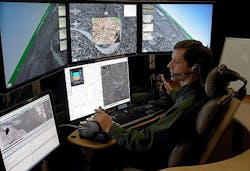Navy asks Raytheon to upgrade UAV control system with open-systems standards and Linux software
PATUXENT RIVER NAS, Md., 7 Feb. 2014. U.S. Navy aviation experts will continue working with the Raytheon Technical Services Co. in Dulles, Va., to switch a major unmanned aerial vehicle (UAV) control system from Solaris to Linux software, and upgrade the system with universal UAV control qualities.
Officials of the Naval Air Systems Command at Patuxent River Naval Air Station, Md., announced plans this week to issue a follow-on sole-source contract to Raytheon to upgrade the company's Vertical Takeoff and Landing Unmanned Air Vehicle (VTUAV) Tactical Control System (TCS), which was designed to help operators fly the Northrop Grumman MQ-8 Fire Scout unmanned helicopter.
The upcoming contract to Raytheon will switch the VTUAV TCS block II from the Solaris to the Linux version B2VL software, and continue evolving the system to the military's new unmanned aerial system (UAS) Control Segment (UCS) Architecture.
The Raytheon TCS is designed to operate UAVs in all branches of the U.S. military, as well as NATO STANAG 4586-compliant UAVs. Raytheon developed the TCS to run on the proprietary Sun Microsystems Solaris 8 software operating system, which is approaching the end of its useful life in U.S. military applications.
Raytheon will continue converting TCS software that runs the Fire Scout to the open-source Linux operating system. The Solaris and Linux operating systems both are based on the Unix operating system.
The the UAS Control Segment Architecture, or UCS, seeks to develop open-systems standards for a common UAV control system that can operate all U.S. Navy, Air Force, Army, and Marine Corps UAVs that weigh 20 pounds or more.
Related: Navy issues urgent order to equip MQ-8 helicopter UAV with maritime surveillance radar
The goal of the UCS is to develop an architecture for all military services as a common basis for buying, developing, and upgrading a wide variety of U.S. military UAV control systems.
The upcoming contract to Raytheon also will call for the company to upgrade the TCS by integrating modern intuitive controls, automate testing procedures, and upgrade software operating in the field. The value of the contract has yet to be negotiated.
The TCS can be configured in racks for ship-based operations, shelterized as a land-based system, or integrated into a shelter on land vehicles such as the HMMWV.
Related: Next-generation Fire Scout unmanned helicopters to have increased range and payload
There are five levels of TCS functionality. levels I and II enable receipt of imagery. levels III and IV provide command and control of the air vehicle and payload and imagery receipt. level V provides command-and-control, payload control, imagery receipt, and the ability to take off and land.
Navy officials also are asking Raytheon to upgrade the TCS full-motion video capability; upgrade the system's shipboard messaging formats; and include training and simulation capability.
The contract is expected to go to Raytheon, but companies whose officials believe they could do the job should contact the Navy's Karin Weinert no later than 19 Feb. 2014 by email at [email protected], or by phone at 732-323-1177. The Navy may open this job to other companies based on responses.
Related: General Atomics gets Army go-ahead for UAV universal ground control station integration
More information is online at https://www.fbo.gov/spg/DON/NAVAIR/N00019/N00019-14-R-0027/listing.html.
For additional information contact Raytheon Technical Services Co. online at www.raytheon.com/ourcompany/rps, or Naval Air Systems Command at www.navair.navy.mil.

